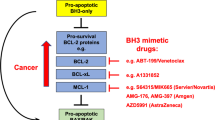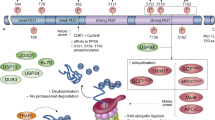Abstract
The human Bfl-1 gene codes for a 175-amino acid BCL-2 family protein that has an anti-apoptosis activity and is overexpressed in certain human epithelial and hematopoietic malignancies. Bfl-1 efficiently suppresses apoptosis induced by the p53 tumor suppressor protein and cooperates with a dominant nuclear oncogene, E1A, in transformation of primary epithelial cells in vitro. Unlike other BCL-2 family proteins, expression of BFL-1 permits limited cell proliferation over an extended period of time when cells are induced to undergo apoptosis. We have carried out mutational analysis to dissect the various activities encoded by Bfl-1 and to determine the sequence requirements for these activities. BFL-1 shares four conserved domains, BH1, BH2, BH3 and BH4 with other BCL-2 family proteins. Mutations within BH1, BH2 and BH4 domains abolish or greatly attenuate the anti-apoptotic, oncogene cooperation and proliferation facilitating activities of BFL-1. In contrast, a mutation within the BH3 domain (which is essential for the activity of pro-apoptotic members of the BCL-2 family) does not significantly affect the BFL-1 functions. Although BFL-1 does not contain a well-defined C-terminal transmembrane domain, deletion of the C-terminal 24 amino acid region (corresponding to the transmembrane domain of other BCL-2 family proteins) partially reduces the various activities of BFL-1. All the mutants defective in the anti-apoptosis activity are also defective in the oncogene cooperation activity suggesting that these two activities may be linked. A unique feature of BFL-1 is the presence of a Gln-rich N-terminal region that overlaps with the BH4 domain. The Gln residues appear to be essential for the proliferation permitting activity of BFL-1. Since mutations of the Gln residues located within the BH4 domain appear to confer an extended cell survival activity in the absence of cell proliferation, our results suggest that BFL-1 communicates with both cell proliferation and apoptosis machineries and suggest a link between these two activities.
This is a preview of subscription content, access via your institution
Access options
Subscribe to this journal
Receive 50 print issues and online access
$259.00 per year
only $5.18 per issue
Buy this article
- Purchase on Springer Link
- Instant access to full article PDF
Prices may be subject to local taxes which are calculated during checkout
Similar content being viewed by others
Author information
Authors and Affiliations
Rights and permissions
About this article
Cite this article
D'Sa-Eipper, C., Chinnadurai, G. Functional dissection of Bfl-1, a Bcl-2 homolog: anti-apoptosis, oncogene-cooperation and cell proliferation activities. Oncogene 16, 3105–3114 (1998). https://doi.org/10.1038/sj.onc.1201851
Received:
Revised:
Accepted:
Published:
Issue Date:
DOI: https://doi.org/10.1038/sj.onc.1201851
Keywords
This article is cited by
-
Bfl-1/A1 functions, similar to Mcl-1, as a selective tBid and Bak antagonist
Oncogene (2008)
-
Constitutive proteasome-mediated turnover of Bfl-1/A1 and its processing in response to TNF receptor activation in FL5.12 pro-B cells convert it into a prodeath factor
Cell Death & Differentiation (2005)
-
The role of apoptosis in the development and function of T lymphocytes
Cell Research (2005)
-
Comparison of mammary gland involution between 129S1 and C57BL/6 inbred mouse strains: differential regulation of Bcl2a1, Trp53, Cebpb, and Cebpd expression
Oncogene (2004)
-
Bfl-1S, a novel alternative splice variant of Bfl-1, localizes in the nucleus via its C-terminus and prevents cell death
Oncogene (2003)



